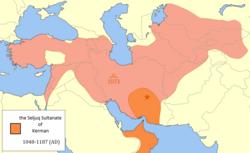
Back سلاجقة كرمان Arabic Kirman səlcuqiləri Azerbaijani Seljúcides de Kirman Catalan Kerman-Seldschuken German سلجوقیان کرمان Persian 케르만 셀주크 술탄국 Korean Kermano sultonatas Lithuanian سلجوقیان کرمان PNB Sultanato Seljúcida da Carmânia Portuguese Керманский султанат Russian
Kerman Seljuk Sultanate قاوٙرْدیان یا آل قاوٙرد | |||||||||||
|---|---|---|---|---|---|---|---|---|---|---|---|
| 1041 (429 AH)–1187 (583 AH) | |||||||||||
 | |||||||||||
| Status | Monarchy | ||||||||||
| Capital | Kerman | ||||||||||
| Capital-in-exile | Bam, Iran | ||||||||||
| Common languages | Persian | ||||||||||
| Religion | Sunni Islam | ||||||||||
| Government | De facto: Independent Sultanate of Seljuks De jure: Under Caliphate | ||||||||||
| Sultan | |||||||||||
| Historical era | Middle Ages | ||||||||||
• Established | 1041 (429 AH) | ||||||||||
• War with Great Seljuks (Kerj abudulaf) | 1073 (465 AH) | ||||||||||
• Murdered of Iranshah of Kerman | 1101 (495 AH) | ||||||||||
• Civil Wars | 1169-1176 (563-572 AH) | ||||||||||
• invasion of Ghuzz | 1180 (575 AH) | ||||||||||
• Disestablished | 1187 (583 AH) | ||||||||||
| |||||||||||
| Today part of | |||||||||||
The Kerman Seljuk Sultanate (Persian: سلجوقیان کرمان Saljūqiyān-i Kerman) was a Persianate Sunni Muslim state, established in the parts of Kerman and Makran which had been conquered from the Buyid dynasty by the Seljuk Empire which was established by the Seljuk dynasty, which was of Oghuz Turkic origin. The Founder of this dynasty, Emadeddin Kara Arslan Ahmad Qavurt who succeeded the ruler of this dynasty after the surrender of the ruler of Buyyids, Abu Kalijar Marzuban.[1] For first time in this period, an independent state was formed in Kerman; eventually, after 150 years, with the invasion of the Ghuzz leader Malik Dinar, the Kerman Seljuk Sultanate fell.
The government is the first powerful local government in the Kerman and Makran region, which, in addition to political and security stability, could create economic prosperity in the provinces. It was during this period that the Silk Road burgeoned with the flourishing of the ports of Tiz, Hormuz and Kish, and this state, as the highway of this important economic road, could use tremendous wealth with the conditions it had created. Regarding the scientific and social conditions, at this time, with the efforts of the Shahs such as Muhammad-Shah II, the scientific and cultural centers were established in Kerman, and with these actions, Kerman, which was away from the main scientific centers, became the center of science in the southeastern region of Iran's plateau. In addition, Kerman and Makran under ruling of Seljuk, grew in agriculture and Animal husbandry, and Progressed in Commerce and trade which led to improved economic and social conditions.
© MMXXIII Rich X Search. We shall prevail. All rights reserved. Rich X Search